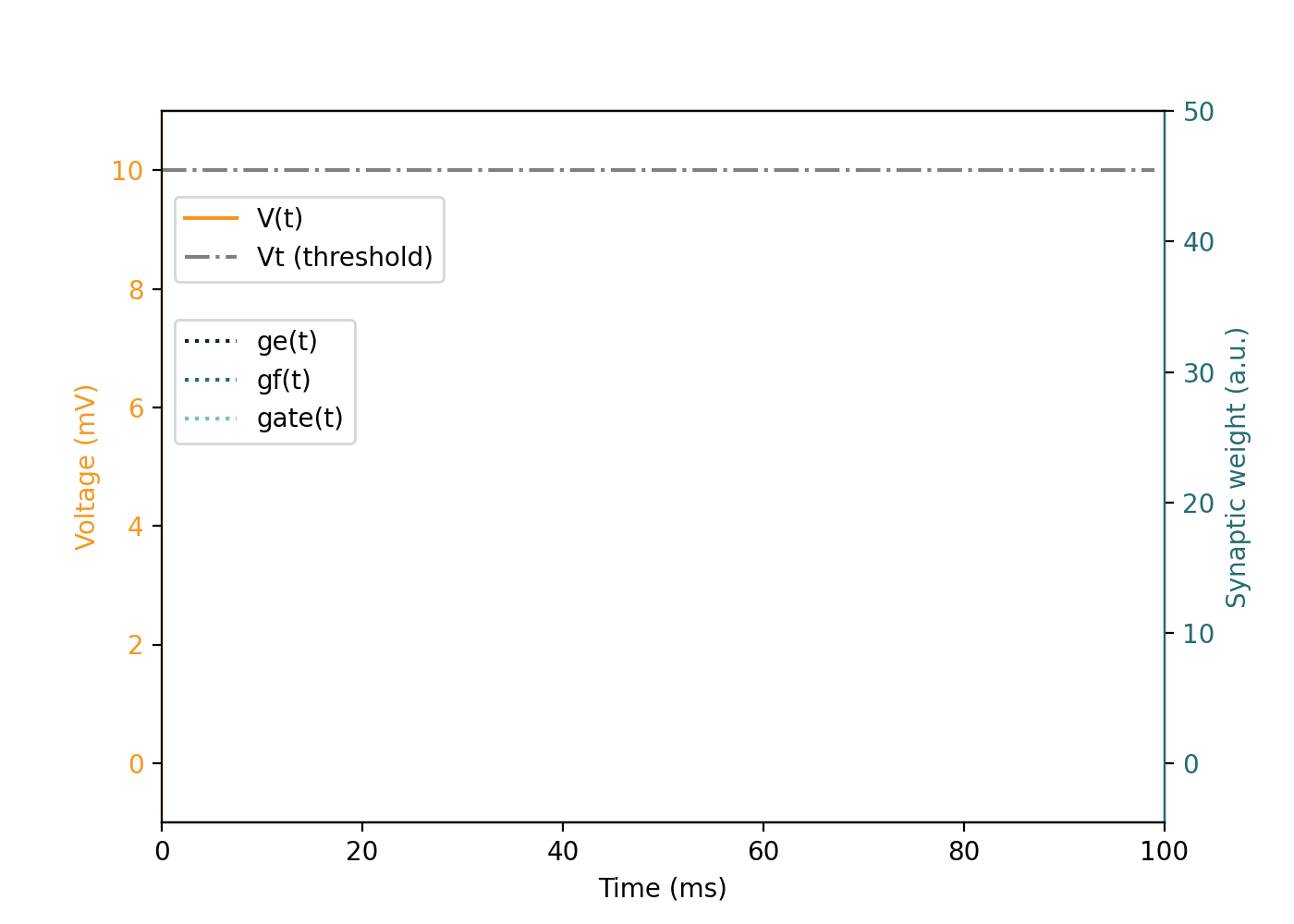Neuron Model
This document details the spiking neuron model used in Axon, which implements the STICK computation framework. STICK uses temporal coding, precise spike timing, and synaptic diversity for symbolic and deterministic computation.
Overview
Axon simulates event-driven, integrate-and-fire neurons with:
- Millisecond-precision spike timing
- Multiple synapse types with distinct temporal effects
- Explicit gating to modulate temporal dynamics
The base classes are:
AbstractNeuron: defines core membrane equationsExplicitNeuron: tracks spike times and enables connectivitySynapse: defines delayed, typed connections between neurons
Neuron Dynamics
Axon simulates event-driven non-leaky integrate-and-fire neurons.
The membrane potentail (V) evolves following the differential equations:
\[ \tau_m \frac{dV}{dt} = g_e + \text{gate} \cdot g_f \] \[ \frac{dg_e}{dt} = 0 \] \[ \tau_f \frac{dg_f}{dt} = -g_f \]
Each neuron has 4 internal state variables:
| Variable | Description |
|---|---|
V | Membrane potential |
ge | Constant input |
gf | Exponential input |
gate | Binary gate controlling gf |
Each neuron also has 4 internal parameters:
| Parameter | Description |
|---|---|
Vt | Membrane potential threshold |
Vreset | Membrane potential set after a reset |
tm | Timescale of the evolution of the membrane potential |
tf | Timescale of the evolution of gf |
When the membrane potential surpasess a threshold, V > Vt, the neuron emits a spike and resets:
if V > Vt:
spike → 1
V → Vreset
ge → 0
gf → 0
gate → 0
Neuron Model Animation
This animation demonstrates the evolution of an individual neuron under different synaptic inputs (V, ge, gf, gate):

| Synapse Type | Behavior |
|---|---|
V | Instantaneous jump in membrane potential V, potentially emitting spike |
ge | Slow, steady increase in V over time |
gf + gate | Fast, nonlinear voltage rise due to exponential dynamics |
gate | Controls whether gf affects the neuron at all |
Event-by-event explanation of the animation
| Time (ms) | Type | Value | Description |
|---|---|---|---|
t = 10 | V | 3.0 | Instantaneous pushes of V, membrane potential |
t = 25 | ge | 6.0 | Applies constant integration current: slow, linear voltage increase |
t = 40 | gf | 16.0 | Adds fast-decaying input, gated via gate = 1 at same time |
t = 40 | gate | 1.0 | Enables gf affecting neuron dynamics |
t = 85 | spike | - | Neuron emits a spike and resets its state |
Synapse Types
The neuron model has 4 synapse types. Each of them affects one of the 4 internal state variables of the neuron receiving the synapse. Synapses have a certain weight (w):
| Synapse Type | Effect | Explanation |
|---|---|---|
V | V += w | Immediate change in membrane potential |
ge | ge += w | Adds to the constant input |
gf | gf += w | Adds to the exponential input |
gate | gate += w | Toggles gate flag (w = ±1) to activate gf |
Besides it’s weight w, wach synapse also includes a delay, controlling the the time taken by a spike travelling through the synapse to arrive to the following neuron and affecting it’s internal state:
synapse
| weight
| delay
Numerical Parameters
By default, Axon uses the following numeric values for the neuron parameters
| Parameter | Numeric value (mV, ms) | Meaning |
|---|---|---|
Vt | 10.0 | Spiking threshold |
Vreset | 0.0 | Voltage after reset |
tm | 100.0 | Membrane integration constant |
tf | 20.0 | Fast synaptic decay constant |
Units are milliseconds for time values and millivolts for membrane potential values.
Benefits of This Model
This neuron model is designed for interval-coded values. Time intervals between spikes directly encode numeric values.
The neuron model has dynamic behaviours that eenable symbolic operations such as memory, arithmetic, and differential equation solving. The dynamics of this neuron model forms a Turing-complete computation framework (for in depth information, refer to the STICK paper).
This neuron model has the following characteristics:
- Compact: Minimal neurons required for functional blocks
- Precise: Accurate sub-millisecond spike-based encoding
- Composable: Modular design supports hierarchical circuits
- Hardware-Compatible: Ported to digital integrate-and-fire cores